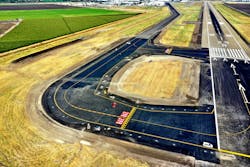2020 Airport Business Project of the Year: Stockton Metropolitan Airport Upgrades Its Airfield for Cargo Operations
- Location: Stockton Metropolitan Airport (SCK)
- Project: Airfield Upgrades
- Cost: Taxiway B extension: $4.17 million; SA CAT II ILS: $3.5 million
- Completion: January
- Key Participants: FAA, RS&H, DACO Construction, Collins Electric, George Reed Construction
Stockton Metropolitan Airport has become an important center for air cargo because of its proximity to the San Francisco Bay Area, interstate highways and favorable economic setting. In response to the air cargo airlines’ need for increased runway length and improved instrument landing minimums, the airport undertook an ambitious program to upgrade its existing Instrument Landing System (ILS) from a Category I to a Special Approach Category II as well as extend existing parallel Taxiway B to allow large aircraft to access the full length of Runway 11L-29R.
Stockton Airport Director Russell Stark, C.M., oversaw the program, arranged funding for the project and assured seamless coordination between the project team, airport staff and the cargo airlines. The effort successfully achieved the program’s objectives without interruption in the cargo operation at the Airport, was on schedule and budget, and had a perfect construction safety record.
Stark said the airport’s current air cargo client’s rapid world-wide growth further expanded air cargo traffic at Stockton. They’ve been able to accommodate the cargo traffic by being innovative and quickly responding to the market.
“I believe this ability to adapt is a direct reflection of our size and commitment from our local leadership and stakeholders throughout the region,” he said. “For example, when the current cargo client approached us about possible operations at Stockton Metropolitan, we were able to lease an area and erect a temporary structure to quickly establish an operations center to load and unload up to four 767s per day.”
The project relocated the physical end of Runway 29R and required close coordination between the FAA led project to upgrade the Special Approach Category II ILS and the RS&H Inc. led Taxiway B extension. RS&H, was responsible for coordination with the FAA, design of the Taxiway B extension and other supporting items.
Due to runway safety area (RSA) restrictions, the project was divided into two phases. Phase 1 took place completely outside the RSA of Runway 11L-29R, which did not affect runway operations. Phase 2 took place within the current RSA and required a temporary closure of Runway 11L-29R. Closure of Runway 11L-29R and Phase 2 construction work were restricted to the hours from 4 a.m. to 1 p.m. and the runway was reopened each day. The total cost of the program was $8.2 million and was completed in approximately five months.
Coordination required extensive analysis to pinpoint the new physical end of Runway 29R because of the demanding geometric and slope requirements associated with a Special Approach Category II ILS. Focused working sessions with the FAA and RS&H design teams proved to be the key to success as each group shared information and simultaneously advanced the designs.
“The real challenge for this project was how to coordinate this as well as the SA CAT II project work together with minimal impact on our aviation community,” Stark said. “I must say, that the deputy director at the time Ron Elliott, Operations Supervisor Helene Nussbaumer, the RS&H staff as well as the FAA and the company conducting the Taxiway B work came together and devised a plan that allowed for the work to be completed efficiently and with only a few exceptions, with minimal impact on our airport activity.
Joe Jackson, vice president, RS&H said coordination during design between RS&H and FAA Air Traffic Organization was initially facilitated by Stark and quickly progressed into a seamless team working to the same end – ensuring that both designs would enable the construction to be completed simultaneously with minimal runway downtime.
FAA Air Traffic Organization staff were mission-focused and worked collaboratively with our designers to overcome the various constraints imposed by the civil and NAVAIDs aspects of the program.
“One of the most challenging variables was the final location of the end of Runway 29R in relation to State Highway 99, which is less than 1,000 from the runway end. Detailed analysis and coordination with FAA Flight Procedures was necessary to assure compliance with all FAA Part 77, TERPS, MALSR light plane, and other instrument approach criteria,” Jackson said. “In the end, an existing blast wall had to be lowered approximately five feet to maximize the useable runway length. The teamwork really paid off as the designs were refined to capture as much pavement as possible.”
The FAA project to upgrade the Special Approach Category II ILS included modification of the Runway 29R Medium Intensity Approach Light System with Runway Alignment Indicator Lights (MALSR), upgrading the Glide Slope and Localizer equipment, and replacement of the Runway Visual Range (RVR) system. RS&H supported the effort with projects to relocate the Runway 29R PAPI, replace all Runway Distance Remaining signs, modify an existing jet blast wall and establish (chart) a Special Approach CAT II for Runway 29R.
RS&H performed planning, engineering, bidding and construction phase services to extend the existing parallel Taxiway B and construct a new connector taxiway to the Runway 29R end. The Taxiway B project consisted of the demolition of approximately 23,100 square yards of existing AC pavement and construction of approximately 27,500 Square yards of new AC taxiways, taxiway shoulders, holding bay, edge lights, grading, drainage infrastructure and the associated permitting efforts.
“Teamwork meant that RS&H had to do more than just engineering – we brought in our planners to update the ALP, our environmental and grant folks to gain NEPA clearance and grant funding, our NAVAIDs engineers and planners to coordinate with FAA Air Traffic Organization to get the Special Authorization CAT II Approach designed and constructed in concert with the TW B work, and our construction specialists to keep the teamwork going with the contractors though the construction of the program,” Jackson said. “By working as a team with the owner, FAA, and contractors, the client’s needs were met by the planning and design effort and the contractors were able to perform the work flawlessly, with minimal impact to operations, and in a safe manner.”
Stark said good preparation and planning, including contingencies, is the key to such a project. Get your team together early. Spend time with staff and key stakeholders discussing the project. They spent time and effort to fully understand every aspect of the process prior to starting. They had a timeline in mind, they knew the costs, they had a good layout of the future geometry through the airport Layout Plan and they got the environmental processing (NEPA and CEQA) taken care of in advance.
“So put together a solid plan, test it for flaws and then implement it with attention to detail to take care of any deviations with your contingency, so those little bumps do not become big problems later,” he said.
Learn More About The Project
Stockton Airport Director Russell Stark shares the insights of the airfield upgrades that were named one of the 2020 Airport Business Projects of the Year on a recent episode of the AviationPros Podcast.
About the Author
Joe Petrie
Editor & Chief
Joe Petrie is the Editorial Director for the Endeavor Aviation Group.
Joe has spent the past 20 years writing about the most cutting-edge topics related to transportation and policy in a variety of sectors with an emphasis on transportation issues for the past 15 years.
Contact: Joe Petrie
Editor & Chief | Airport Business
+1-920-568-8399
>> To download the AviationPros media kits, visit: Marketing Resource Center
>>Check out our aviation magazines: Ground Support Worldwide | Airport Business | Aircraft Maintenance Technology

